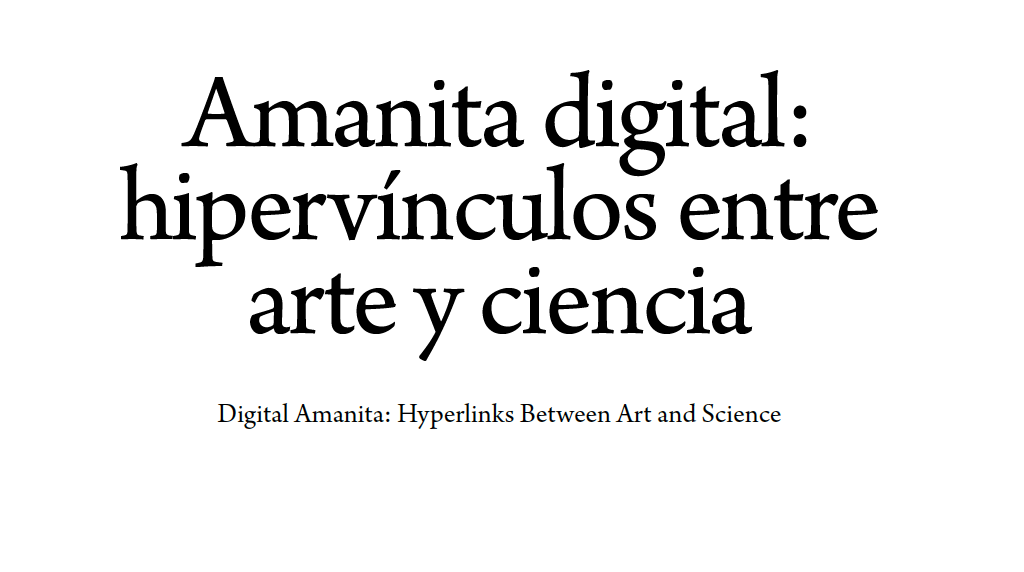Digital Amanita: Hyperlinks Between Art and Science
DOI:
https://doi.org/10.46516/inmaterial.v10.247Keywords:
artistic research, LED, mushrooms, blue, art-science-technologyAbstract
Known colloquially as “mushrooms” in the field of computer engineering, blue LEDs appeared in 1993 as a new invasive species capable of economically providing colour to screens and filling the world with electronic devices. In this context, the Amanita digital artistic research project links mycology, the social character of mushroom hunting and the toxicity of blue mushrooms with the morass of emotions (sadness, decay, disappointment, etc.) associated with this colour to ask, through art, whether technological overindulgence can have as a side effect the current blue feeling that characterises contemporary society. Using a parallel with agricultural and scientific techniques, a blue LED farm was created and many digital mushrooms were cultivated. Their physiological changes were also recorded in an online scientific and artistic diary in order to understand the eternal symbiosis between technology, nature, society and art. Finally, the conglomerate of themes and methodologies used in this project builds an article that exposes the potential of dialogue between disciplines. The metaphorical relationship between LED lights and mushrooms – the project’s key elements – allows us to approach the operation of and some of the social consequences of screens in contemporary society from other viewpoints.
Downloads
References
Agustí, E. y Vilà, A. (2014). Una analogía adecuada. En A. Vela (Directora del proyecto de investigación), MetaMétodo. Metodologías compartidas en procesos artístico (p. 81-95). Comanegra.
Alsina, P. (2020). Interseccions entre art, ciència i tecnología [Conferencia registrada en video]. Universitat Oberta de Catalunya.
Amandolse, D. y Basque BioDesign Center (2024). Growing Futures. Web oficial proyecto de investigación MUSAE. Consultado el 28 de marzo de 2025. https://musae.starts.eu/activities-dfa-projects/
Andevert, A. M. (2023). Tros de dona [Exposición]. Museu Terra. https://museuterra.cat/tros-de-dona/.
Badia, T. (2024). Malles, diagrames, nusos i grapes. Conversa sobre metodologies artístiques en projectes d’art i ciència i presentació dels quaderns GRAPA. CCCB.
Berardi, F. (2015). Heroes: Mass murder and suicide. Verso Books.
Bradbury, R. (2021). Las maquinarias de la alegría. Minotauro.
Broto, L. (2014). Observaciones en un laboratorio. En A. Vela (Directora del proyecto de investigación), MetaMétodo. Metodologías compartidas en procesos artístico (p. 46-49). Comanegra.
Cantera, A. L. y Ferrari, D. (2018). Cartografías invisibles. Web oficial de la artista. Consultado el 28 de marzo de 2025.
https://www.analauracantera.com.ar/cartografias-invisibles
Careri, F. (2024). Walksacapes. El andar como práctica estética. Gustavo Gili.
Carroll, L. (2015). Alicia en el país de las maravillas. Alianza editorial.
Eklöf, J. (2023). Manifiesto por la oscuridad. Cómo la contaminación lumínica amenaza nuestros ritmos de vida. Rosamerón.
Guardiola, I. (2019). L’ull i la navalla. Un assaig sobre el món com a interfície. Arcàdia.
Han, B-C. (2016). Psicopolítica. Herder.
Han, B-C. (2018). La sociedad del cansancio. Herder.
Heller, E. (2008). Psicología del color. Cómo actúan los colores sobre los sentimientos y la razón. Gustavo Gili.
Jarman, D. (Director). (1993). Blue [Película]. Basilisk Communications, Uplink, Arts Council of Grat Britain, Opal y BBC Radio3.
Jarman, D. (2019). Naturaleza moderna. Caja Negra.
Kopf, A. (2008). Maneres de (no) entrar a casa.
https://aliciakopf.blogspot.com/2008/09/. [Fecha de consulta: 02/09/2024].
Kopf, A. (2010). Die Weltmeere Wunderatlas von A. K. https://aliciakopf.tumblr.com/page/21. [Fecha de consulta: 02/09/2024].
Laux, H. E. (2012). Setas de España y Europa. Tikal.
Llevadot, L. (2022). Mi herida existía antes que yo. Feminismo y crítica a la diferencia sexual. Tusquets.
Lowenhaupt, A. (2021). La seta del fin del mundo. Sobre la posibilidad de vida en las ruinas capitalistas. Capitán Swing.
Manovich, L. (2017). El lenguaje de los nuevos medios de comunicación. La imagen en la era digital. Paidós.
Manubens, A. (2015). Visceral blue. Ajuntament de Barcelona y BCN Producció. https://www.lacapella.barcelona/system/files/2018-08/BCN-PR-15_FullSala_Comissariat_ESP.pdf. [Fecha de consulta: 03/09/2024].
Manubens, A. (2016). Visceral blue. Ajuntament de Barcelona y FolchStudio.
Llevadot, L. (2022). Mi herida existía antes que yo. Feminismo y crítica a la diferencia sexual. Tusquets.
Marín, A. (2021). Bolets del Vallès: com identificar-los, dites populars i altres curiositats. La llar del llibre edicions.
Ostendorf-Rodríguez, Y. (2024). Seamos como los hongos. El arte y las enseñanzas del micelio. Caja Negra.
Oxford University Press. (s.f.). Blue. En Oxford Learner’s Dictionaries. https://www.oxfordlearnersdictionaries.com/definition/english/blue_1?q=blue. [Fecha de consulta: 10/08/2024].
Pera, P. (2022). Aún no se lo he dicho a mi jardín. Errata naturae.
Pérez, R. (2013). El LED azul: su aplicación en comunicaciones por luz invisible. Revista de la Academia Canaria de Ciencias: = Folia Canariensis Academiae Scientiarum, 25(2), 115-125. https://hdl.handle.net/20.500.12285/racc/323.
Pla, J. (1971). Les hores. Ediciones Destino.
Pla, J. (1981). El que hem menjat. Ediciones Destino.
Sampedro, J. (2017). El arte de Cajal para explicar la ciencia. El País. https://bit.ly/37aL92v. [Fecha de consulta: 13/08/2024].
Shanken, E. (2011). Nuevos medios, arte-ciencia y arte contemporáneo: ¿hacia un discurso híbrido? Artnodes, 11, 5-61. https://openaccess.uoc.edu/bitstream/10609/10088/1/artnodes-n11-shanken-esp.pdf
Sheldrake, M. (2020). La red oculta de la vida. Cómo los hongos condicionan nuestro mundo, nuestra forma de pensar y nuestro futuro. Geoplaneta.
The Nobel Prize. (12 de agosto de 2024). Shunji Nakamura – Nobel Lecture. https://www.nobelprize.org/prizes/physics/2014/nakamura/lecture/. [Fecha de consulta: 12/08/2024].
Yehya, N. (2024). El planeta de los hongos. Una historia cultural de los hongos psicodélicos. Anagrama.
Zheludev, N. (2007). The life and times of the LED – a 100 year history. Nature Photonics, 1(4), 189-192. https://doi.org/10.1038/nphoton.2007.34. [Fecha de consulta: 12/08/2024].

Published
How to Cite
Issue
Section
License
Copyright (c) 2025 Marc Anglès Cacha

This work is licensed under a Creative Commons Attribution-ShareAlike 4.0 International License.






